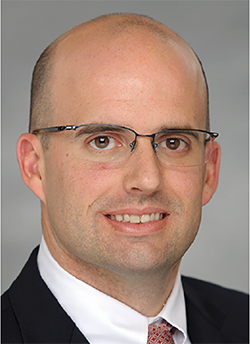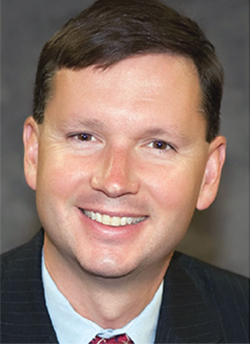2017 Power Broker
Nonprofit
Keeping Schools’ Missions at the Forefront

Brandon Cole, CPCU, CRM, CIC, ARM-P, RPLU, CISR, AINS
Area Vice President
Arthur J. Gallagher, Irvine, Calif.
School clients count on Brandon Cole to provide them the risk management education they need to perform their missions.
Oakland, Calif.-based Thrival World Academies, a new nonprofit, was designing a program to provide publicly subsidized education abroad to racially and socio-economically diverse students. “Since we were in our design phase, many aspects of our program shifted during this period, and Brandon supported us through all of these shifts,” said Executive Director Emma W. Hiza.
“He helped us to understand our insurance needs, to get quotes and ultimately bind all of the liability — domestic and foreign,” she said. Cole also “has participated in meetings with the school district where we are working to help us discuss shared risk and negotiate with their insurance officials,” Hiza said.
“Without the insurance coverages that Brandon supported us in obtaining, we would not have been able to launch this fall.” she said. “His consistently quick response time has been critical to our success.”
At the Brooklyn Prospect Charter School in Brooklyn, N.Y., Cole not only provided guidance on travel insurance options when students studied abroad but also ensured that the institution managed the risk of taking students outside the country, said Hillary Prince, director of finance. “We’ve since had three international trips, and everyone came home safely, so that’s priceless,” she said.
Streamlining Coverage on a Budget
Nonprofit organizations count on Jason Helfert for much more than placing insurance.
CSF Illinois, an agency that supports children and adults with disabilities, tapped Helfert for help completing a merger with another organization.
“As one would suspect, the merger process is complicated, especially in our industry,” said Chief Executive Officer Mary Pat Ambrosino. “We must deal with private business factors, state issues and family issues, sometimes concurrently. While our organization went through a complicated, lengthy process, Jason Helfert helped us navigate every insurance issue that needed to be addressed with ease.
“Knowing that our organization did not have to worry about a lapse in coverage put our minds at ease, smoothing the transition period,” Ambrosino said, “Further, our costs remained relatively the same, and Jason had no monetary incentive for consolidating two existing coverages into one.”
Another nonprofit faced climbing workers’ compensation claims and costs. Helfert aided the agency in establishing a board that meets regularly to review accidents and recommend changes in policies and procedures to prevent future accidents. The board consists of agency staff and experts from Horton and the agency’s insurer.
“In the last fiscal year, our costs were almost 20 percent lower than the previous year, when we did not have the review board,” an agency official said.
Finding an Insurance Structure That Works
Ken Porter’s church clients depend on his sophisticated approach to their insurance needs.
An independent consultant noted that a mutual client was not confident in the claims information a third-party administrator provided, largely because the client had a “less-than-centralized approach” in managing its various entities, including schools, churches and charities.
Porter worked with the client’s legal team to jettison the disjointed insurance arrangement and beef up its general insurance and misconduct insurance trust. “He arranged for excess insurance of varying amounts, depending on the exposures presented, and utilized an independent casualty actuary to set up appropriate funding for losses and expenses of the trust,” the consultant said.
“The trust structure should also help to keep the client’s other assets from being subject to attachment in the event of lawsuits. There should be savings in the future due to reinsurers potentially becoming involved because of the more formal trust structure.”
The client’s risk manager noted that the trust arrangement means the client no longer needs to purchase costly misconduct coverage and can direct the savings of several hundred thousand dollars to the trust. “We have been able to now conduct actuarial studies on the program as well as to have clearly defined financial accountings of each trust account” that is distinguishable from the general operations, the risk manager said.
Focusing on Cost Control
Nonprofits count on Bill Powell to help rein in overhead costs.
A large social services agency with a stratospheric 140 percent workers’ compensation loss ratio faced skyrocketing insurance premiums. Powell took over the account and first ensured that the agency’s claims were reserved and handled properly. Then he initiated loss-projection studies and an experience modifier analysis.
Facing a nonrenewal from the incumbent carrier, Powell marketed the program to more than a dozen insurers, investigating first-dollar as well as self-insured options.
After the agency selected United Heartland as the insurer, Powell worked with the carrier to provide the agency enhanced loss control assistance. That included monthly safety meetings and disseminating regular safety and loss control flyers to employees. In 2016, when it faced budget problems because of its state’s own budget woes, the agency’s loss ratio plummeted to 25 percent, resulting in a 25 percent premium reduction.
“We were getting priced out of the traditional insurance market and were facing the possibility of being forced into a risk pool,” an agency official said. “Once we were able to partner with United Heartland, the impact to our risk management program and claims was almost immediate.”
Another client, a Midwestern university, realized a 2 percent reduction in overall premiums. That “was testament to Bill’s [marketing] strategy,” one school official said.
No Project Too Big or Deadline Too Tight
Chris Schwyter handles issues large and small for clients.
As Villanova University began a $300 million expansion project, it faced risks related to its proximity to the community and a major roadway. Risk management also inherited professional liabilities for design architects and engineering work and other risks stipulated in the contract of the appointed general contractor. Plus, the local township also had collateral requirements for site improvements, said Director of Insurance and Risk Management Ashlie Docktor.
Schwyter’s team “secured protection for Villanova with project-specific coverage for professional liability and environmental liability,” Docktor said. He also assisted in negotiations with the contractor to set worksite safety protocols and transfer some risks back to the contractor or subcontractors. In addition, he placed site-improvement bonds to meet the township’s requirements, Docktor said.
“We increased our protection for the construction project for professional and environmental liabilities and saved considerable money in the switch from letter-of-credit collateral to the surety bond,” Docktor said, “More importantly, the solutions allowed Villanova to proceed on schedule without delay.”
Schwyter helped another university client update its enterprise risk management program by providing resources that helped risk management engage senior management, the client said.
Proactively Tackling Liability Risk
When a federal jury determined The Hotchkiss School in Connecticut must pay a $41.5 million damage award to a former student who contracted a debilitating tick-borne disease on a school trip to China, the ruling caught the attention of The Alexandria Country Day School five states away in Alexandria, Va.
Alexandria’s business manager, Robert Powers, was concerned that the case might mean his private day school’s own liability coverage was insufficient. Powers immediately contacted his broker Derek Symer for a solution.
Symer negotiated a “sufficient coverage increase that did not substantially impact [the school’s] budget,” Powers said. For the next fiscal year, Symer found “more robust coverage — at a cost reduction,” he said, providing much needed relief to a stressed budget.
With all of their school clients, Symer and his team at AHT Insurance have made a priority of discussing duty of care — both in terms of buying insurance and running workshops on how to mitigate the risk.
Another client, the Maret School in Washington, D.C., wanted to help parents with student-busing assistance without shouldering additional liability.
“Derek’s guidance was quite helpful,” said Darwin Walker, Maret’s assistant head of finance and operations. “Derek’s solid advice enabled the parents and the school to find a workable solution” that relieved the parents of a huge logistical burden while avoiding additional school liability.















